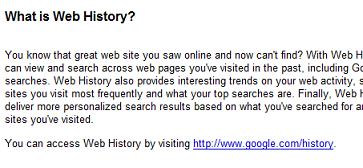Sunday, December 2nd, 2007
At times, I was wondering why would an author link to an invalid site in their new article. It could be caused by typing mistakes but the author should always try to click on their own link before they publish the article.
I found one common mistake that lots of people would make. Google has a goodbad example on this.
At this What is Web History? help page, if you point to the link in the page (refer the following image), you will see a weird link at status bar.

What I saw in status bar:

If the author used the following code to link, he will get the problem.
<a href="www.enrii.com">enrii.blog</a>
The author should include "http://" to avoid the problem.
<a href="http://www.enrii.com">enrii.blog</a>
So, web programmers, take note about this!
Sunday, November 25th, 2007
The 'Alternate' (Alt) key of my friend's notebook keyboard got stuck. So, when he presses A, the computer accepts it as Alt + A. The immediate solution that I can think, is to disable the key.
I find that it's not hard to disable a key. Here's how to do it:
- Download MapKeyboard from download.com (27KB only)
- Uncompress it, then open the MapKeyboard.exe (not installation is required)
- A virtual key board will show up.
- Click on the key that you want to disable. For my case, I click on RAlt to disable right Alt key.
- Then at "Remap selected key to:", select "Disabled".
- Finally, click "Save layout" and reboot the PC
If you failed to start the program, you will need to install Microsoft .Net Framework 2.0.
I think this can be useful, especially for some gamers who would like to disable the Windows key for you-know-what reason.
Besides disabling a certain key, the program can map keys as well.
Hope you find it useful too.
Friday, November 23rd, 2007
Windows XP: I was trying to start my apache web server but it seems like some other application has stolen my port 80. I never had this problem before.
After a few searches I learned a few commands that helped me to identify which process that actually listening to port 80.
- Go to command prompt (Start > Run > cmd)
- Type in: netstat -aon
- You will see a list of IP numbers, port numbers and the process ID (PID).
- Look for the row with 127.0.0.1:80 and remember the process ID.
- Open up Task Manager (Start > Run > taskmgr)
- Go to Process tab, click View > Select Columns...
- Tick PID (Process Identifier)
- Search the process that has the same process ID shown in netstat and you will find the culprit!
For my case, it's the Skype that occupied my port 80. I later found out that it can be disabled in the options menu.
Saturday, November 17th, 2007
A traveling friend told me that she's not able to view any websites with Firefox or MSN. Even MSN messenger is not working. The strange thing is skype is working properly.
What could possibly cause that? A search in Google leads me to another person with the same problem. He failed to get any good answer from the respondents.
A test to ping google.com failed. But a test to ping google's IP address works! It must be domain name server (DNS)!
Her PC was configured with DNS from Malaysian internet service provider (ISP). I told her to remove those DNS servers to make the internet works as usual again.
If you are facing the same problem, refer to this article to remove DNS: How to configure TCP/IP to use DNS in Windows XP
Saturday, September 22nd, 2007
The new Internet Sharing feature in Windows Mobile 6 claimed that it saves lots of hassles to share a 3G/GPRS internet connection from a PDA running on WM6 to a laptop or computer. But it was a bad experience for me. It took hours for me to make it work.
Before you even try to do this, you should make sure that your PDA can browse the web with its 3G/GPRS. If it's not working, you should ask your mobile service provider to get the configuration right. Some service provider requires you to activate the service before using it.
Here the steps on how I finally did it using the USB cable way:
- On your PDA, tap Start > Programs > Internet Sharing.
- Select "USB" for "PC Connection"
- For "Network Connection", choose the one that you will use to connect to your 3G from PDA. For my case, I'm using "Maxis Internet".
- Tap "Connect". The PDA will attempt to connect to the USB, then to the internet using 3G.
- Then, at your laptop, you will see a network connection, just like another LAN connection that you have.
That's it! You should be able to access the internet by now.
To share a connection with bluetooth has almost the same steps, except that you will need to create partnership between your laptop with your PDA first.
I have a few troubleshooting tips if you can't get it working on your first try.
- You may need to turn off or configure your Windows Firewall or other firewall that you are using.
- You should disable other Local Area Networks (LAN) if you have any. (This is the problem that costs me hours)
- You may need to disable USB connection in the connection settings of your ActiveSync.
- You may need to disable advanced network functionality in your WM6. Go to Start > Settings > Connections > USB to PC to find it.
- Having all above done and still not able to get it working, you may try to read help file from WM6. In your PDA, go to Start > Help. Search for "Internet Sharing".
Before I forget, the one important thing that you must do, is to check the price per KB from your service provider. The package that I have here is 1sen/KB. That is equivalent to RM10 (USD 3) per MB. It's expensive but sometimes, it helps when you need to check something urgently.
Enjoy surfing.


